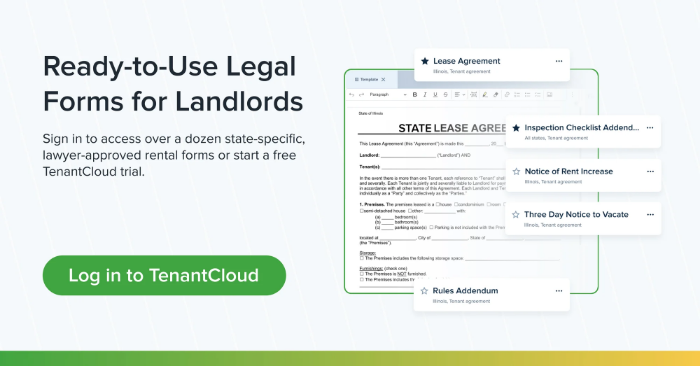Whether you're a landlord or tenant, handling an eviction can be a challenging experience. If you own rental property in Florida and need to evict a tenant, keep in mind that Florida has a unique set of steps to follow. Even if you are currently not evicting a tenant, understanding how the Florida eviction process works is crucial.
In this guide, we'll explore how long an eviction takes, what a written notice is and how to provide one, and what you can expect throughout the process. We'll also discuss tenant and landlord rights and offer tips on how to keep a record to help avoid eviction-related problems.
TL;DR
Florida’s eviction process requires landlords to follow strict legal steps, including giving written notice, filing a court case, serving the tenant, and obtaining a Writ of Possession. A new 2025 law (HB 615) now allows eviction notices to be sent by email if both parties agreed in writing. Evictions in Florida take anywhere from a few weeks to several months, depending on tenant response, legal holidays, and court schedules. Keeping detailed records is essential for a smooth process.
Key Updates to Florida Law
House Bill 615
A new House Bill was passed July 2025 which now gives landlords the ability to send notices to tenants via email. They must first gain mutual consent in writing, most commonly via their signed lease or rental agreement. Previously, landlords and property managers had to serve tenants with a physical written notice. [More details]
Note: This electronic option does not apply to official court documents like the eviction complaint, summons, or write of possession.
What is An Eviction?
An eviction is the civil process where a landlord can legally remove a tenant from their rental property. An eviction may occur for various reasons. While it is unlawful for a landlord to evict a tenant at any time, a landlord can remove a tenant for lease violation. If the tenant signed the rental agreement, they have the right to reside in the property as defined in the lease unless they do any of the following:
- Failure to pay rent
- Break the rules outlined in the lease agreement (smoking, having pets on the property when not allowed, etc.)
- Damage or fail to maintain the rental unit
- Disrespect or disturb neighbors or damage other tenants property
 If, however, the tenant did not sign a lease or rental agreement, the landlord may be able to evict the tenant at any time without reason as long as proper notice is provided to the tenant.
If, however, the tenant did not sign a lease or rental agreement, the landlord may be able to evict the tenant at any time without reason as long as proper notice is provided to the tenant.
How Much of a Notice to Provide in Florida?
According to Fla. Stat. § 83.57, the amount of notice needed in Florida is 60 days for year-to-year leases, 30 days for quarterly and monthly leases, and seven days for week-to-week contracts.
 For more details on reasons to evict, see Fla. Stat. § 83.52.
For more details on reasons to evict, see Fla. Stat. § 83.52.
Lease Renewals in Florida
According to Florida laws, leases that are expired do not automatically renew, so tenants who continue to rent are considered without a lease. If you are a property owner or manager, make sure to renew your leases as early as possible to protect your property. If you are a tenant, make sure to renew your lease so that you have legal rights as well.
Evicting a Tenant in Florida
Florida law prohibits taking measures outside the eviction process when dealing with non-payment of rent or other lease violations. If you're a landlord and you plan to evict a tenant, make sure to follow the legal process correctly, which we'll outline below.
Importantly, avoid these methods at all costs:
- Retaliating after a tenant requests repairs or reports code violations
- Shutting off utilities such as water, electricity, or gas to force tenants out
- Removing doors or changing locks
- Forcibly removing tenants or their belongings without a court order
- Discriminating tenants based on protected characteristics such as race, religion, disability, gender, or family status
 Provide a Written Notice
Provide a Written Notice
Let's say a tenant fails to pay rent or withholds rent even after several reminders. In order to reclaim the rental unit, you'll need to let the tenant know that they're being evicted. You can do this by one of three types of eviction notices: three day notice, seven day with an opportunity to correct, or an unconditional seven day notice.
Note: Like stated above, new Florida law states that these notices can now be delivered to the tenant via email, which saves several steps. However, you'll need to have asked for consent in the rental agreement and have it signed at the beginning of the lease.
Three Day Notice in Florida
The most common notice landlords give tenants before eviction is the three-day notice, typically used when a tenant fails to pay rent. This notice gives the tenant three days to pay the overdue rent in full. Otherwise, the landlord can take eviction action.
Seven Day Notice with Cure in Florida
A 7-day notice is typically used when a violation not related to rent payment has occurred. In this case, the landlord can issue a notice to the tenant to “cure” or rectify the situation. If the tenant has not resolved the issue within the time frame, the landlord can continue the eviction process.
Note: The seven days does not include the day that the notice is served but does include weekends and legal or non-legal holidays.
Seven Day Notice without Cure in Florida
If the tenant causes significant property damage or repeats the same violation more than once in 12 months, the landlord can terminate the lease with a no-cure notice of seven days. The tenant then has seven days to vacate the property without further warning. This is typically used for extreme violations, not failure to pay rent.
File an Eviction Lawsuit
After the landlord has given notice to the tenant, the next step is to file an eviction lawsuit in the county court associated with the area of the rental property. The landlord must file a summons and complaint, which outlines the reasons for eviction.
The complaint should provide the information needed to file an eviction, including:
- Information about the landlord and tenant
- The property location
- List of tenant violations
- A request to evict the tenant
- Lease agreement details
- Written notices
The landlord should come prepared with the information above. They will also need to pay a filing fee of anywhere from $100-$200, depending on the courthouse.
Note: If the tenant was served a three day notice and is able to pay rent by this time, you cannot continue with the eviction proceedings.
Serve the Tenant
Once the paperwork is filed at the courthouse, the eviction summons and complaint need to be served to the tenant. Usually, this will be handed to the tenant in person by either the county sheriff or a third party that specializes in personal service, also known as delivering court documents to the person being served.If you have consent to serve tenants by email, court documents must still be delivered in person.
There may be additional legal and court costs associated with filing court documents and serving the tenant.
After the tenant receives the summons and complaint, they have five days to file a response in writing at the same county clerk's office. The tenant typically pays any filing fees. If the tenant responds to the court, a hearing is set, and a judge is assigned.
The court hearing is a pivotal part of the process, as both the landlord and tenant must physically appear on the requested date and present their case before a judge. Both parties should bring a copy of the complaint, as well as any evidence (including screenshots, photos, witnesses, etc.).
What's a Writ of Possession?
At the hearing, a judge will listen to both sides and determine the final judgment. The final judgment is the court's final decision that ends the case and resolves all issues between parties. If the court rules in the landlord's favor, a court clerk will issue a Writ of Possession.
The Write of Possession is a legal document allowing a sheriff to remove a tenant from the rental property if they do not leave within a certain period, usually 24 hours. A Writ of Possession also grants the landlord repossession of their property. This document is usually left at the tenant's door or handed to the tenant by the sheriff or clerk. A landlord does not deliver the Writ of Possession.
The Final Eviction
After the final judgment, Writ of Possession, and 24 hour period, the deputy can arrive at the property and physically remove the tenant, if necessary. The landlord can then change the locks, inspect the property, remove a tenant's belongings, and secure the building under the safe watch of the deputy.
If a tenant leaves behind more possessions than the landlord can remove, the landlord may need to gather movers to eject the remaining items on the property.
How Long Do Eviction Proceedings Take in Florida?
The eviction process in Florida can take anywhere from a few weeks to several months. The exact duration may vary, so patience is key.
Tenant Rights
Tenants in Florida have rights that protect them from unfair or unlawful eviction practices. These rights include the following:
- A proper eviction notice with a specific reason for eviction
- Ability to contest eviction and present their case to a judge
- The right to remain on the property until a court order is issued
- The right to request repairs or maintenance
- Privacy while living in the rental, except for proper notices and emergencies
 Can Tenants Take Legal Action?
Can Tenants Take Legal Action?
Yes, tenants can take legal action if a landlord or property owner fails to follow the eviction laws. Not only can they sue for monetary damages, but they can also request several months of rent and attorney fees, so it's always best to follow eviction laws properly.
Landlord Eviction Rights
Landlords have specific rights in Florida. Knowing their rights can help avoid unlawful or risky behavior. Landlord rights include the following:
- The right to serve proper eviction notices when tenants violate the lease
- Ability to file an eviction lawsuit when tenants do not comply
- The right to inspect and maintain the rental property as long as they've provided proper notice to tenants before entering, except in emergencies
- Receive rent payments on time
- The right to regain possession of their property through proper procedures if a tenant does not pay rent or violates the lease
 How to Keep Records Ahead of Time
How to Keep Records Ahead of Time
It's a good idea to record all interactions and transactions between landlord and tenant just in case. Providing physical proof to a judge goes a long way and can help make your case. Here are some tips on staying organized:
- Keep records of all communication with your tenant or landlord, including emails, text messages, and written notes.
- Track detailed records of rent payments, including dates, amounts, and payment methods, to establish a payment history.
- Document property inspections and maintenance requests to show you are fulfilling your responsibilities
- Keep signed copies of the lease agreements for reference.
- If you need to evict tenants, store all notices and court documents in a safe, secure place.
Stay Ahead of Legal Issues with TenantCloud
It's easy to navigate the Florida eviction process when you understand each step and why it's crucial. By following the procedures outlined above, remembering landlord and tenant rights, and keeping a thorough record, you can have a successful outcome and reduce the stress of eviction.
The easiest way to have all your payment records and tenant details in one place? TenantCloud's property management software. Try a 14-day free trial today!
Frequently Asked Questions
How long does the eviction process take in Florida?
Florida evictions generally take a few weeks to several months, depending on whether the tenant contests the case, how quickly notice is served, and the court’s schedule.
Can a landlord evict a tenant without going to court?
No. All residential evictions in Florida must go through the court system.
Landlords cannot change locks, shut off utilities, or physically remove tenants.
Can eviction notices be sent by email in Florida?
Yes, they can, as of July 2025 (HB 615)—but only if the tenant gave written consent (usually in the lease), and the notice is not a court document.
What are tenants’ rights during an eviction?
Tenants have the right to receive proper notice, contest the eviction in court, remain in the unit until a judge issues a final judgment, and be free from retaliation or discrimination.




